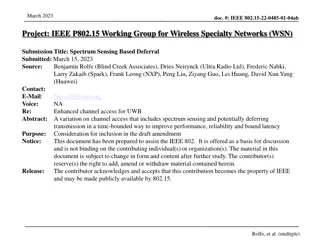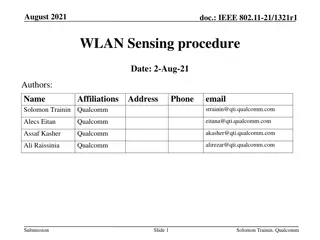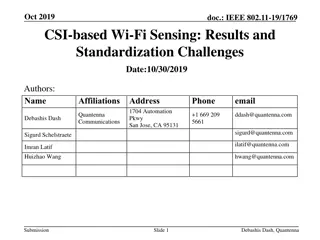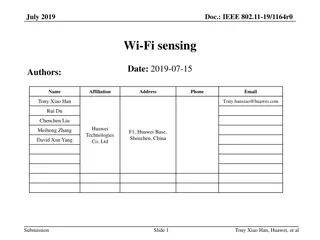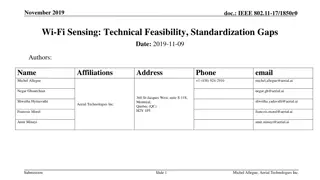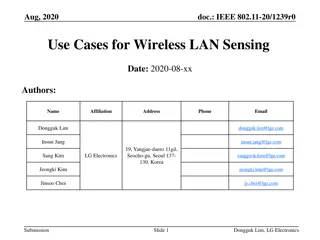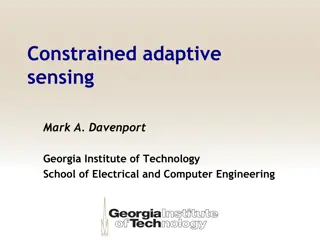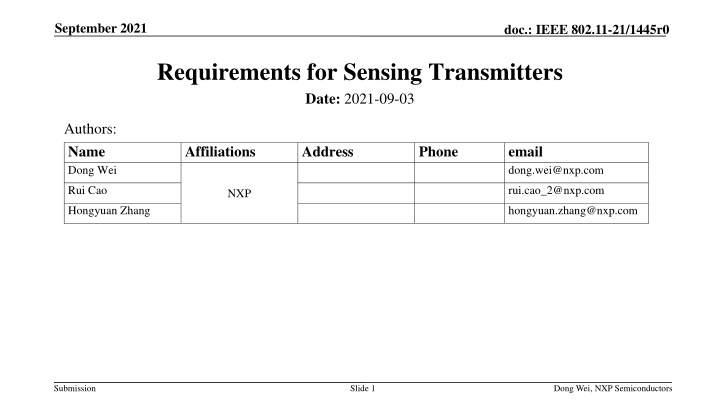
Requirements for Sensing Transmitters in IEEE 802.11-21/1445r0 Document
Explore the requirements for sensing transmitters in CSI-based WLAN sensing as discussed in the IEEE 802.11-21/1445r0 document. Discover how measuring CSI variations over time is crucial for various WLAN sensing applications such as human presence detection, motion detection, and activity recognition. Learn about the importance of maintaining consistent transmit power levels for accurate sensing measurements.
Download Presentation

Please find below an Image/Link to download the presentation.
The content on the website is provided AS IS for your information and personal use only. It may not be sold, licensed, or shared on other websites without obtaining consent from the author. If you encounter any issues during the download, it is possible that the publisher has removed the file from their server.
You are allowed to download the files provided on this website for personal or commercial use, subject to the condition that they are used lawfully. All files are the property of their respective owners.
The content on the website is provided AS IS for your information and personal use only. It may not be sold, licensed, or shared on other websites without obtaining consent from the author.
E N D
Presentation Transcript
September 2021 doc.: IEEE 802.11-21/1445r0 Requirements for Sensing Transmitters Date: 2021-09-03 Authors: Name Dong Wei Affiliations Address Phone email dong.wei@nxp.com Rui Cao rui.cao_2@nxp.com NXP Hongyuan Zhang hongyuan.zhang@nxp.com Submission Slide 1 Dong Wei, NXP Semiconductors
September 2021 doc.: IEEE 802.11-21/1445r0 Abstract Requirements for sensing transmitters in CSI-based WLAN sensing are discussed. Submission Slide 2 Dong Wei, NXP Semiconductors
September 2021 doc.: IEEE 802.11-21/1445r0 Introduction It is agreed that CSI (that is, the channel measured during the training symbols of a received PPDU) is a type of sensing measurement result for sub-7 GHz WLAN sensing. For a wide range of WLAN sensing applications, measuring and monitoring CSI variation over time are essential. A time series of CSI measurements captures how wireless signals travel through surrounding objects and humans in the time, frequency, and spatial domains. For example, CSI amplitude variations in the time domain have different patterns for different humans, activities, gestures, etc., which can be used for human presence detection, motion detection, activity recognition, gesture recognition, and human identification/authentication. Submission Slide 3 Dong Wei, NXP Semiconductors
September 2021 doc.: IEEE 802.11-21/1445r0 Introduction (cont d) To measure a single snapshot of CSI, a sensing transmitter needs to transmit a sounding PPDU (e.g., an NDP) to a sensing receiver. To obtain a time series of CSI measurements, the sensing transmitter is required to transmit consecutive sounding PPDUs to the sensing receiver. CSI-based WLAN sensing can be impacted by dynamic changes in sensing transmitter configurations (e.g. transmit power and transmit beamforming). It can become challenging to distinguish between CSI variations caused by the activities of a sensing target and caused by changes to transmitter configurations. In contribution 11-20-1851-03-00bf-Overview-of-Wi-Fi-sensing-protocol, it was suggested: PHY configuration freeze/hold PPDUs used for measurement shall be transmitted with same set of transmit parameters . Submission Slide 4 Dong Wei, NXP Semiconductors
September 2021 doc.: IEEE 802.11-21/1445r0 Transmit Power It is desirable to avoid CSI fluctuation caused by changes to transmit power at a sensing transmitter. TXVECTOR represents a list of parameters that the MAC sublayer must provide the local PHY entity in order to transmit a PPDU. TXPWR_LEVEL_INDEX is one of the TXVECTOR parameters. This parameter is used to indicate which of the available transmit output power levels shall be used for the current transmission. The mapping between a TXPWR_LEVEL_INDEX value and the actual transmit power is implementation dependent. When transmitting consecutive sounding PPDUs, the MAC sublayer of the sensing transmitter shall not change the TXPWR_LEVEL_INDEX parameter of the TXVECTOR. Submission Slide 5 Dong Wei, NXP Semiconductors
September 2021 doc.: IEEE 802.11-21/1445r0 Transmit Beamforming WLAN transmitters may use beamforming which changes the amplitude and phase of CSI measurements. This completely changes CSI patterns and makes CSI-based sensing significantly more challenging since the beamforming matrix may not be available at the sensing receiver. If transmit beamforming is used by the sensing transmitter, then its steering matrix shall be kept unchanged during the process of transmitting consecutive sounding PPDUs to the sensing receiver. Submission Slide 6 Dong Wei, NXP Semiconductors
September 2021 doc.: IEEE 802.11-21/1445r0 Trigger Frame based Sounding Consider the scenario of a STA (e.g. an AP) serving as a sensing initiator who initiates a WLAN sensing session and performs sensing measurements. The sensing initiator transmits a trigger frame (TF) to one or more sensing responders to solicit NDP transmissions. After receiving the trigger frame, each sensing responder transmits an NDP to the sensing initiator. To obtain a time series of CSI measurements, the above two steps (i.e. transmission of TF and NDP) may be repeated between a pair of sensing initiator and responder. Since the sensing initiator has no information about either the transmit power or the transmit BF steering matrix at the sensing responder, the following two requirements shall be met by the sensing responder in order to avoid any CSI fluctuation caused by changes to transmitter configurations: The MAC of each sensing responder should keep the TXPWR_LEVEL_INDEX value unchanged during the process of transmitting consecutive sounding NDPs to the sensing initiator. If transmit BF is used by the sensing responder, then its steering matrix shall be kept unchanged during the process of transmitting consecutive sounding NDPs to the sensing initiator. Submission Slide 7 Dong Wei, NXP Semiconductors
September 2021 doc.: IEEE 802.11-21/1445r0 NDPA-based Sounding Consider the scenario of a STA serving as a sensing initiator who initiates a WLAN sensing session and another STA serving as a sensing responder who performs sensing measurements. The sensing initiator transmits an NDP Announcement frame and an NDP to the sensing responder. The sensing responder feedbacks CSI measurements to the sensing initiator. To obtain a time series of CSI measurements, the above two steps (i.e. transmission of NDPA/NDP and measurement feedback) may be repeated between a pair of sensing initiator and responder. While the sensing initiator has the knowledge about its transmit power and transmit BF steering matrix, it is beneficial if the following two requirements are met by the sensing initiator in order to avoid any CSI fluctuation caused by changes to transmitter configurations, as the alternative is to compensate for the CSI fluctuation after receiving the CSI measurements, which may lead to unnecessary complexity. The MAC of the sensing initiator should keep the TXPWR_LEVEL_INDEX value unchanged during the process of transmitting consecutive sounding NDPs to the sensing responder. If transmit BF is used by the sensing initiator, then its steering matrix shall be kept unchanged during the process of transmitting consecutive sounding NDPs to the sensing responder. Submission Slide 8 Dong Wei, NXP Semiconductors
September 2021 doc.: IEEE 802.11-21/1445r0 Summary CSI fluctuation caused by changes to transmitter configurations can degrade WLAN sensing performance. To avoid this performance degradation, requirements for transmit power and transmit beamforming at a sensing transmitter are discussed. Submission Slide 9 Dong Wei, NXP Semiconductors
September 2021 doc.: IEEE 802.11-21/1445r0 SP1 Do you agree with the following? o For TF-based sounding, the MAC sublayer of the sensing transmitter shall not change the TXPWR_LEVEL_INDEX parameter of the TXVECTOR when transmitting multiple sounding NDPs to the sensing receiver during a sensing session. Submission Slide 10 Dong Wei, NXP Semiconductors
September 2021 doc.: IEEE 802.11-21/1445r0 SP2 Do you agree with the following? o For NDPA-based sounding, the MAC sublayer of the sensing transmitter shall not change the TXPWR_LEVEL_INDEX parameter of the TXVECTOR when transmitting multiple sounding NDPs to the sensing receiver during a sensing session. Submission Slide 11 Dong Wei, NXP Semiconductors
September 2021 doc.: IEEE 802.11-21/1445r0 SP3 Do you agree with the following? o For TF-based sounding, if transmit beamforming is used, then the steering matrix at the sensing transmitter shall be kept unchanged when transmitting multiple sounding NDPs to the sensing receiver during a sensing session. Submission Slide 12 Dong Wei, NXP Semiconductors
September 2021 doc.: IEEE 802.11-21/1445r0 SP4 Do you agree with the following? o For NDPA-based sounding, if transmit beamforming is used, then the steering matrix at the sensing transmitter shall be kept unchanged when transmitting multiple sounding NDPs to the sensing receiver during a sensing session. Submission Slide 13 Dong Wei, NXP Semiconductors




